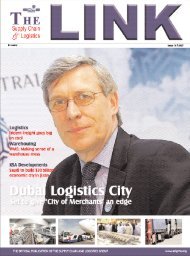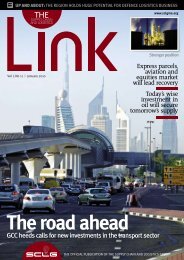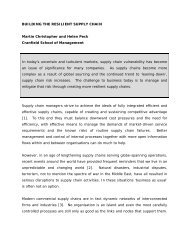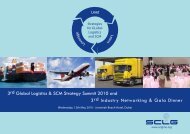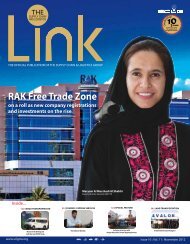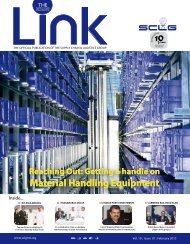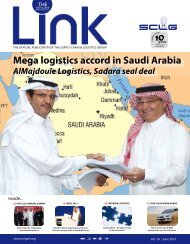Free to Download - SCLG
Free to Download - SCLG
Free to Download - SCLG
- TAGS
- download
- sclg
- sclgme.org
Create successful ePaper yourself
Turn your PDF publications into a flip-book with our unique Google optimized e-Paper software.
IRELAND SPECIAL Economics<br />
serious about Value for Money this cannot<br />
be allowed <strong>to</strong> continue. The integrated<br />
approach <strong>to</strong> procurement and supply chain<br />
has been advocated for over a decade now<br />
and many organisations are striving <strong>to</strong> adopt<br />
the concept. This time presents us not only<br />
with challenges but also with the opportunity<br />
<strong>to</strong> make those radical changes for effective<br />
procurement in<strong>to</strong> the future.<br />
We will explore some aspects of<br />
the integrated approach and how it can<br />
influence VFM. Organizations that effectively<br />
collaborate with their procurement and<br />
supply chain partners position themselves<br />
for success in 21st-century markets. When<br />
focused methods, and tried and tested<br />
techniques are adopted or transferred <strong>to</strong><br />
specifically address the objectives of the<br />
Procurement and Supply Chain arena, the<br />
results are always positive, by contributing<br />
substantial savings, efficiencies and<br />
benefits.<br />
When these methods and techniques<br />
are followed it means that you are working<br />
<strong>to</strong> a set of practices and principles that<br />
deliver benefits in a consistent manner.<br />
There is a growing awareness that<br />
Integrated Procurement and Supply Chain<br />
management provides the extra edge for<br />
greater efficiency and differentiate itself<br />
from the competition. One way <strong>to</strong> achieve<br />
this is for Procurement managers <strong>to</strong> look at<br />
their operation from a holistic perspective<br />
by adopting effective, proven methods<br />
<strong>to</strong> increase the chances of success.<br />
Conversely if you don’t manage your<br />
purchases and supply activities in a planned<br />
and structured way, and you continue <strong>to</strong><br />
do what you have always done, you will<br />
continue <strong>to</strong> get what you have always got.<br />
Even with decades of hands on<br />
experience in the procurement and supply<br />
chain arena, we at MRM-Global never cease<br />
<strong>to</strong> be amazed at the number of different<br />
ways roles have adapted. There is no single<br />
method of execution, and that can lead <strong>to</strong><br />
The importance of<br />
effective procurement<br />
and supply is summarised<br />
as “Provide continuity<br />
of supply of goods and<br />
services ’’<br />
16 Link January 2011<br />
difficulties when being held accountable<br />
for efficiency improvements and/or cost<br />
reductions against a common background of<br />
expectations.<br />
Without doubt effective procurement<br />
can provide a vital contribution through<br />
VFM and yet, <strong>to</strong>o often, no clear vision or<br />
integrated action plan <strong>to</strong>wards achieving this<br />
objective is present. Why is this? There<br />
appears <strong>to</strong> be no clear answer. Excuses are<br />
abundant as <strong>to</strong> why certain things cannot<br />
be done. The sheer volume and complexity<br />
of purchasing and supply activities for the<br />
majority of public organisations creates a<br />
scenario where there is usually little time and<br />
fragmented or no data/information available.<br />
This lack of consolidated data creates a<br />
problem because of the many variables<br />
associated with procurement and SCM. This<br />
often results in ‘fire-fighting’ becoming the<br />
order of the day. Planned areas of activity<br />
are often focused only on a part of the<br />
whole, for example inven<strong>to</strong>ry turns, leaving<br />
other areas of opportunity untapped and<br />
inadequately managed.<br />
The importance of effective procurement<br />
and supply might be summarised as follows:<br />
‘’Provide continuity of supply of goods<br />
and services at lowest cost and minimum<br />
contractual risk’’. From a performance<br />
perspective, in private sec<strong>to</strong>r procurement, a<br />
1% saving is equivalent, from a profitability<br />
perspective, <strong>to</strong> a minimum of a 10% increase<br />
in sales. A similar analogy needs <strong>to</strong> be<br />
developed for VFM in the public sec<strong>to</strong>r. This<br />
puts procurement in<strong>to</strong> a position of being<br />
an important contribu<strong>to</strong>r and a strategic<br />
necessity and not an order department. If<br />
we take one element of supply costs for<br />
example, inven<strong>to</strong>ry, a primary focus will be <strong>to</strong><br />
achieve optimum s<strong>to</strong>ck turn rates. Not only<br />
will this support providing high service levels<br />
when properly managed, but also frees up<br />
valuable working capital. With coordinated<br />
actions good inven<strong>to</strong>ry management will<br />
influence how well warehousing operates<br />
and, in turn, logistics.<br />
By integrating these efforts on a cross<br />
functional level VFM will be optimised<br />
through integrated procurement. So how<br />
do you achieve Integrated Procurement<br />
and Supply Chain Management (IPSCM)?<br />
We at MRM-Global believe the answer lies<br />
in the design of the process itself. Some<br />
processes work better than others and the<br />
better ones tend <strong>to</strong> have a more holistic<br />
approach. The processes that are not as<br />
The Four Courts Dublin<br />
good are more fragmented in their design.<br />
From our research we have found that the<br />
integrated approach delivers better results.<br />
This is evidenced by results from a number<br />
of organisations, providing substantial<br />
improvements in efficiencies and cost<br />
reductions. The process supporting IPSCM,<br />
when it incorporates project and portfolio<br />
based models, improves performances<br />
even further. Project and portfolio elements<br />
have been proven <strong>to</strong> provide substantial<br />
benefits. Unless the process reflects<br />
and complements cross functional interrelationships<br />
from demand planning <strong>to</strong><br />
fulfilment, and the associated operating<br />
procedures, the danger of a fragmented<br />
process remains. We have studied these<br />
areas and have integrated our findings in<strong>to</strong><br />
the creation of a new process model. We<br />
have developed a process that supports end<br />
<strong>to</strong> end procurement and supply.<br />
Whilst most practitioners will readily<br />
acknowledge the logic <strong>to</strong> the process, <strong>to</strong>o<br />
often they are constrained in implementing<br />
such a model due <strong>to</strong> work pressures. This<br />
is one of the main reasons that integration




